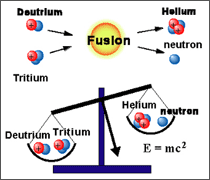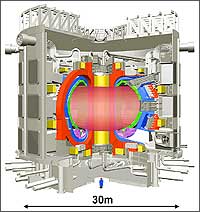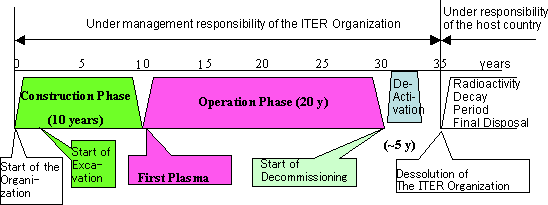ITER
August 2007
1. What is ITER?
ITER is an international project to construct and operate an experimental fusion reactor aiming at proof of the scientific and engineering feasibility of the fusion which is expected to be an ultimate source of energy for human kind with almost inexhaustible supply of the fuel and environmental friendliness. About 10 years of construction and 20 years of operation are foreseen.
2. What is Fusion?

It is the nuclear fusion reaction that generates heat and light emitted from the sun and stars. We are trying to realize the fusion reaction on earth by putting deuterium and tritium atoms together and transforming them into a Helium atom and a neutron. In this process, the total weight of the reaction products, a helium atom and a neutron, gets slightly lighter than the total weight of the reacting particles, deuterium and tritium atoms. Albert Einstein discovered the relation between mass (m), and energy (E); E=mc², where c is the speed of the light. The energy corresponding to the difference of the mass before and after the fusion reaction is released from the reaction. For example, the fusion reaction with 1g of the fuel composed of deuterium and tritium will produce the energy equivalent of burning 8 tonnes of petroleum (with the reduction of the mass by 1/300 g).
3. Characteristics of Fusion Energy
(1) Abundance of the fuel:
The major fuel, deuterium, abundantly exists in sea water and can be easily extracted, and it is an essentially inexhaustible supply. The tritium would be produced from lithium, which is also abundantly available from sea water or from land deposits. Fuel supply for fusion is thus inexhaustible and not localized in the world.
(2) Inherent Safety:
A large uncontrolled release of energy would be impossible in case of accidents with fusion. The amount of fuel introduced in the fusion reaction chamber is so small that run-away reaction cannot take place. Also, sustainment of the plasma conditions required for the fusion reactions is so demanding, any malfunction would eventually lead to a termination of the reaction. The safety measures and precautions necessary for fusion power reactors will be simpler than those with the fission power reactors.
(3) Environmental Friendliness:
The amount of carbon dioxide release, which is the cause of the global warming, is very small in fusion power reactors. No high-level nuclear waste will be produced. Instead, low level radioactivity will be produced when neutrons from the fusion reactions hit the reactor structure. However, significant reduction of the activated material is expected from progress of the reactor material studies.
4. Overview of the International Cooperation on ITER Project

(1) Outline
(a) The formal inter-governmental negotiation for drafting the Agreement on Joint Implementation of the ITER Project (the ITER Agreement) and for selection of the ITER construction site began in November 2001 with participation of Japan, EU, Russia, and Canada.
(b) In February 2003, US joined the negotiations after almost 4 years of absence from ITER, and the People's Republic of China newly joined the negotiation. After that, the Republic of Korea(June 2003) and India(December 2005) also joined. Canada withdrew from the negotiation in December 2003.
(c) As for the ITER site selection, 4 candidate sites were proposed at the beginning. In December 2003, Rokkasho site proposed by Japan and Cadarache site proposed by EU remained. Finally, on the occasion of the Ministerial Meeting held in Moscow, the 6 parties decided the Cadarache as ITER construction site. (Press Secretary Statement 227)
(d) After the decision of ITER site, the negotiation for legal framework for the ITER Project was held intensively. Consequently, the ITER Agreement and the Agreement on the Privileges and Immunities of the ITER Organization were signed in November 2006. These Agreements will enter into force 30 days after the deposit of instruments of ratification, acceptance or approval by all Signatories.
Pending the entry into force of the ITER Agreement, 7 Signatories have engaged themselves to the preparatory works for ITER construction consistent with their relevant domestic laws and regulations according to the Arrangement of the Provisional Application of the ITER Agreement, which was signed by the 7 Signatories of the ITER Agreement.
Japan deposited the instrument of acceptance on the 29 May 2007 after getting approval of the Diet during its 166th ordinary session.
(2) Development
| 1985 Nov.: | The project was first proposed at the Summit Meeting between Ronald Reagan and Mikhail Gorbachev. |
| 1988-2001 Jul.: | The ITER design activities have been successfully carried out. The design of ITER was completed in July 2001. |
| 2001 Nov.-: | Inter-governmental negotiations on the joint implementation of ITER started. (presently still in progress) |
| 2003 Feb.: | USA rejoined ITER negotiations. |
| 2003 Feb.: | China joined ITER negotiations. |
| 2003 June: | Korea joined ITER negotiations. |
| 2003 Dec.: | Canada withdrew from the ITER negotiations. |
| 2003 Dec.: | First Ministerial-level Meeting was held in Washington. No agreement on site issue. |
| 2005 June: | Second Ministerial-level Meeting was held in Moscow. Participating parties agreed that the ITER will be constructed in Cadarache, France. |
| 2005 Nov.: | Mr. Kaname IKEDA, Ambassador Extraordinary and Plenipotentiary of Japan to the Republic of Croatia was appointed as the Director General Nominee of the ITER Organization. |
| 2005 Dec.: | India joined ITER negotiations. |
| 2006 Nov.: | The ITER Agreement and the Agreement on the Privileges and Immunities of the ITER Organization were signed. 1st ITER Interim Council was held. |
| 2007 July: | 2nd ITER Interim Council was held. |
(3) Schedule

Back to Index
